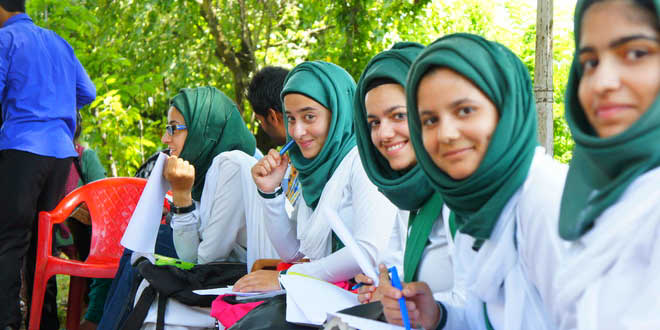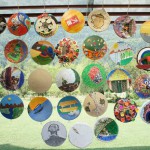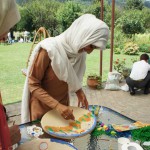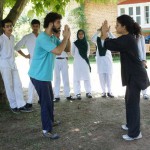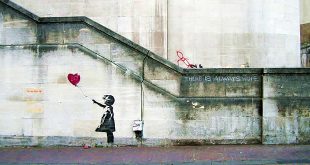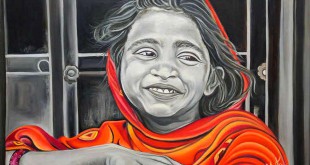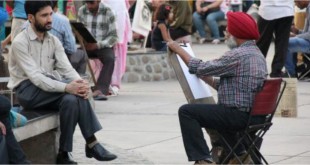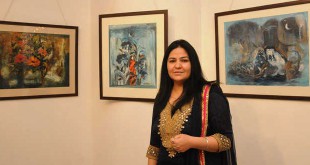The Dara Shikoh Festival, Srinagar, encourages vibrant dialogue, energetic workshops and experiments in theatre, music, photography, poetry and environment to celebrate the heritage of the Valley
A villa set in the middle of 40 acres of almond, apple and pear orchards, the front facing the Dal Lake and the back, the vast Himalayas, becomes the focus of literary and creative energy every year as it hosts the Dara Shikoh Festival of Arts, allowing local students and others to interact with the talented facilitators. An old heritage hunting lodge now home of Dr Jyotsna (Jyoti) Singh, the granddaughter of the last King of Kashmir, Raja Hari Singh, is the host as well as the prime mover of this unique gathering that is now seven years’ old. Immensely charming and awesomely organized Jyoti Singh is called as Rajkumari ji by the local people. She, seemingly effortlessly, gathers around her, the best academic minds, dramatists, poets, photographers and artists of the country. They flock to her home and joyfully participate in the festival while partaking of her gracious yet easy hospitality at the lovely Almond Villa of breathtaking views and divine food. The focus of the centre and the annual festival is to explore and recreate the heritage of Kashmir. The festival aims to acquaint young Kashmiris with their cultural legacy and to promote diversity across the state. Thus, many schoolchildren, college kids and young adults from local educational institutions are invited to participate in the workshops. The diverse interactions enable a symbiotic exchange of thought and ideas.Facilitators for these workshops converge from Delhi, Chandigarh, Leh, Ahmadabad, Srinagar etc. There’s a palpable synergy leading to exciting new ideas of art and philosophy and perspectives on environment and heritage.“Many people don’t realise the diversity that Kashmir has — be it the Kishtwad traditions of Jammu or the Pahadi or the eight dialects you find in Kargil, there are so many oral and folk traditions here” says Jyoti.
Seminars and symposia
The festival includes symposia and seminars, theatre presentations, slide shows and initiatives in environmental matters with people like Sayeda Imam, Sameera Khan (co-author of Why Loiter?), Kanak Mani Dixit (editor of Himal Southasian), Akshay Shah, Neerja Mattoo who’ve shared their views with a lively audience. Every festival usually ends with a performance. The performers and directors over the years have included MK Raina, Suryakanthi Tripathi, Tripurari Sharma, Gopal Gandhi, Madan Gopal and his group, groups from NSD and Mukteshi, the versatile Jammu singer.Every facilitator and resource person has a unique reason to attend the festival. Arun Gupta, HoD of the Film and Video department at NID, convener of the South Asian Documentary and Short Film Festival, Alpavirama, who was there to conduct a his film appreciation class, says: “I’ve always been fascinated by the politics of Kashmir and the consequent impact on the Kashmiri psyche. The invitation to participate gave me the opportunity of close interaction with young people.”
It’s organic!
There’s a unique organic aspect to the festivals. Jyoti’s aim is to provide “long-term programmes in environment, student exchange programmes, and collaboration with the government in projects that find their roots through programmes at Almond Villa.” Thus Akshay Shah of Himalayan Wanderers, which for over a decade, has promoted sustainable nature and adventure tourism in Ranikhet, co-opted the shikara walas and the houseboat walas to work on strategiesof recycling and minimization to clean up Dal Lake. And Pradeep Kishan, filmmaker-turned-environmentalist; author of Trees of Delhi: A Field Guide, is working at re-wilding an acre of Almond Villa and having made a successful microcosm, will present it to the Kashmir Government for replicating.
Shutterbugging
Karam Puri, a renowned photographer whose work includes coffee table books like Gujrat: A Journey, SCHOOL and The Indian Golf Story, has been a steady facilitator in the festival for four years. Puri finds a positive change in the confidence and perspectives of the kids he’s been working with. “A shot is worth a thousand words and remains for perpetuity” he says. “My objective is always to push a few boundaries, encourage the kids to explore new possibilities, and bring about a change in attitudes. At the end of the four-day workshop some kids do realize that visual arts are primary sources of communication.” Evidently, Puri has been successful in firing up the young photographers, because both BBC and Al Jazeera showcased flood related-photographs taken by Aamir Khan and Rayan, two of Puri’s students.
How Creative!
Under a huge chinar tree with the breeze gently rustling through the leaves, you will find the vastly experienced writers, teachers and poetesses, Neerja Mattoo, Nusrat Andrabi and Naseem Shifaie, challenging the kids to explore their creativity through words. Usually at the end of the festival, an annual publication by the Dara Shikoh Centre is produced that consists of the best work produced — short stories, poetry, anecdotes, jokes and introspective pieces in English, Urdu and Kashmiri.“The festival has grown from a participation of 20 kids to over 150 over a period of seven years” says Naseem Shifai.
Arty-Crafty
Dispersed all over the lawns and verandahs are young artists working in large groups or groups of two or even alone; bent over papier mâché plates or chart paper, taking imprints from nature or painting interesting motifs on stones. They use text, paper and mixed media to create a story of the valley; art works that reflect vignettes of the rural and urban facets- of water, mountain, and Kashmiri motifs of chinar leaves, shikaras and samovars. The final products could be murals and collages to finally create artworks that came together as complete works. Young Chemat Dorjey, MFA from Banaras, who works with children in Leh, and participant-turned-facilitator for the art section, says shyly, “Kashmir is beautiful and the children are unique in their ethnicity and attitudes. I love to come here because as much as the children, I learn with them, to imagine and to create.”
Play time
Probably the most lively spot is the venue of where the theatre workshop is being held. It’s usual to find a group of 40 young boys and girls, learning to free themselves of the inhibitions of body and the mind, work as a team, explore new ideas and manners, and learn lessons of teamwork and mutual respect. Lots of noise and action, but there’s a method to the madness that reveals itself as the workshops become more and more intense over four days. MK Raina, teams from NSD and most recently, two super-energetic facilitators, Amba Suhasini Jhala (Toss a Coin theatre group) and Anirudh Nair (Wide Aisle Productions) have been facilitators for the theatre section.“We’ve learnt the value of cooperation. The workshops have been fun but also taught us valuable life skills” says Saud, a student of DPS, Srinagar, while Athar Rafiqi says: “The theatre workshops are a fusion between different ideologies and mindsets of the disparate people of Kashmir.”Jyoti Singh provides what she likes to call a “safe space” for the participants in the festival — a space where the mind is free and creativity can be unleashed and harnessed at the same time. “To create spaces, situations and environments where art, scholars, environmentalists, scientists, writers can come together and disseminate their ideas and to the region that can then be formulated into action plans to make the local more global.”There’s lots of fun; laughter; new ideas and interactions; bursts of music and plenty of productivity. But the process is set in motion and it doesn’t stop when the festival does. Seeds are firmly planted, and at least some will come to fruition in real terms as time passes. What shape Jyoti Singh’s labour of love takes remains to be seen. All one knows is that it’s going to be good!
 Kids Portal For Parents India Kids Network
Kids Portal For Parents India Kids Network
